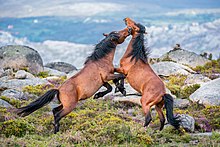Garrano
 Stallions fighting in Peneda-Gerês National Park | |
| Country of origin | Portugal |
|---|---|
The Garrano is a Portuguese breed of small horse. It is equivalent to the Faco Galego of Galicia in north-western Spain.[1]: 402
History

The horse is believed to be an ancient breed, with Northern Iberian Paleolithic cave paintings depicting horses with similar profiles.[1] The similarities between the breed and the depicted animals lead to the conclusion that the breed's appearance has remained stable.[citation needed] There is genetic evidence that the horse originates in Celtic regions, with additional research suggesting the later introduction of males for breeding from north Europe.[1] In the 20th century, the breed was infused with Arab blood.[citation needed]
The breed's numbers have been depleted by wolf predation, as they are a preferred prey. They have also declined as they have become less attractive for agricultural work, as a result of which they have been crossbred with other species for meat. As of 2010, the population of Garrano was estimated at approximately 2,000, with a sex ratio of one stallion to 13 mares.[1]
Characteristics

Members of the breed are usually bay, brown or dark chestnut in color, with a straight or concave facial profile, and stand on average 1.3 metres (12.3 hands; 51 in).[1] They are hardy and quick gaited breed and at one time were raced.[citation needed]
References
- ^ a b c d e José Vingada, Carlos Fonseca, Jorge Cancela, Joana Ferreira, Catarina Eira (2010). Ungulates and their management in Portugal. In: Marco Apollonio, Reidar Andersen, Rory Putman (editors) (2010). European Ungulates and Their Management in the 21st Century. Cambridge: Cambridge University Press. ISBN 9780521760614, pages 392–418.
